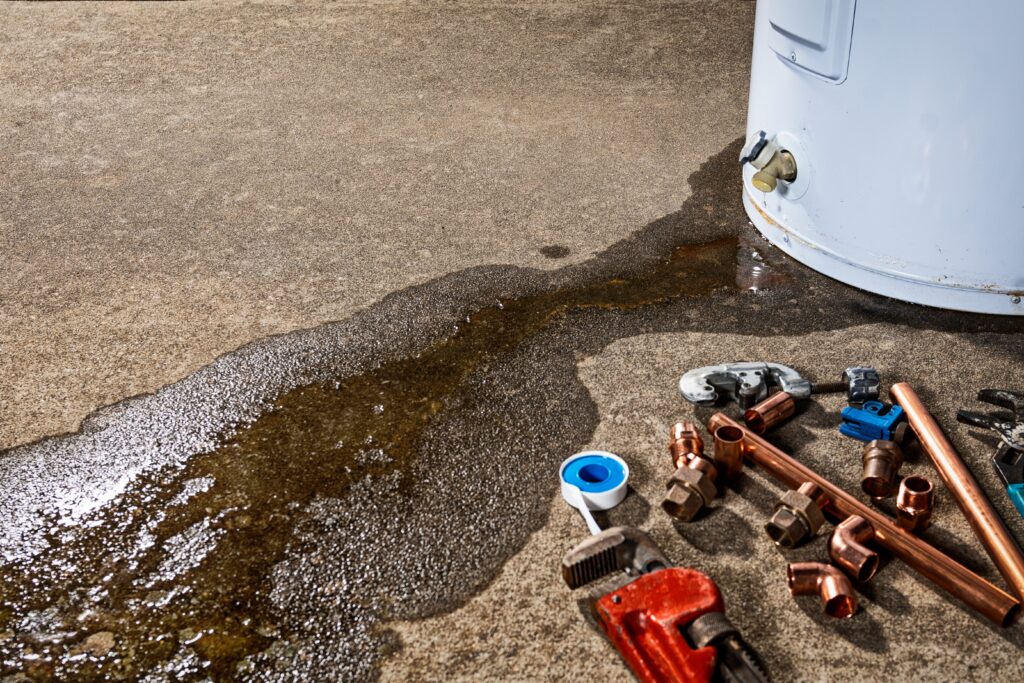
Dealing with a water heater leaking from the bottom can be a concerning situation, but swift action can prevent extensive damage. When faced with such an issue, it’s crucial to first identify the source of the leak. One common culprit is a malfunctioning pressure relief valve, which may lead to water escaping from the bottom of the heater.
At Mayer Plumbing, we understand the urgency of addressing leaking hot water tanks promptly. Our experienced technicians recommend turning off the power supply and shutting off the water to the heater immediately. This prevents further damage and ensures the safety of your home.
Once the initial steps are taken, our team will inspect the pressure relief valve and the tank itself to pinpoint the exact issue. In some cases, a leaking water heater may require professional repair or replacement. Mayer Plumbing specializes in efficient and reliable water heater services, ensuring the longevity of your appliance.
Regular maintenance is essential to extend the water heater’s lifespan and minimize the risk of leaks. By addressing issues promptly and relying on Mayer Plumbing’s expertise, homeowners can enjoy a reliable water heater that lasts long after it starts without worrying about potential leaks.
Common Causes of a Water Heater Leak
Water heater leaks can result from various common issues, often causing inconvenience and potential damage. One prevalent cause is a faulty pressure relief valve, responsible for releasing excess pressure. Sediment buildup at the bottom of the tank is another culprit, leading to corrosion and leaks. Corroded or deteriorated plumbing connections may contribute to water seepage. High water pressure strains the system, causing leaks over time. Temperature fluctuations and aging tanks also play roles. Insufficient maintenance exacerbates these problems. Timely inspection, addressing sediment, and replacing worn components can prevent water heater leaks, ensuring efficient and reliable performance for an extended period.
Addressing the Issue of a Water Heater Leaking from the Bottom
Dealing with a water heater draining from the bottom is a critical issue that demands immediate attention. When a water heater starts leaking, it poses risks of water damage, structural issues, and potential mold growth. Identifying the source of the leak is crucial, as it could be caused by a faulty drain valve, pressure relief valve, or a tank breach. Promptly addressing the problem can prevent further damage and ensure the water heater’s optimal functioning. Homeowners should turn off the power and water supply, assess the extent of the leak, and seek professional assistance for repairs or replacement. Neglecting a water heater draining from the bottom can lead to costly consequences and disrupt daily activities.
Tips for Drainage and Maintenance of a Leaky Water Heater
Proper maintenance is crucial to prevent a leaking water heater disaster. Begin by turning off the breaker to ensure safety. Next, locate the drain valve at the bottom of the water tank and attach a hose to drain the water, flushing out sediment that may cause leaks. If your water heater is leaking persistently, it may be a sign that it needs to be replaced. Consult a plumber to assess the extent of the damage and recommend a suitable replacement. Regular check-ups and timely interventions can extend the lifespan of your water heater, ensuring a reliable supply of hot water without the risk of leaks.
Preventive Measures and Maintenance for Water Heaters
Ensuring the longevity of your water heater involves implementing preventive measures and regular maintenance. Tankless water heaters, in particular, benefit from scheduled descaling to prevent mineral buildup that can compromise efficiency. Check for leaks and corrosion regularly, as catching issues early can extend the water heater’s lifespan. Using the water heater responsibly, such as avoiding excessive hot water consumption, helps it last longer. Regularly flush the tank to remove sediment, a common cause of reduced efficiency. Address any unusual sounds or fluctuations promptly to prevent further damage. By incorporating these practices, you can maximize the lifespan of your water heater and minimize the likelihood of unexpected issues.
Understanding the Safety Features of Modern Water Heaters
In the realm of home appliances, water heaters play a crucial role in providing comfort, yet their operation entails potential risks. Understanding the safety features of modern water heaters is paramount to ensuring a secure and efficient household. Mayer Plumbing, a reputable source in plumbing solutions, sheds light on these critical aspects.
Visit Mayer Plumbing’s website (https://www.mayerplumbing.net/) to explore a wealth of information on cutting-edge water heater safety features. From pressure relief valves to temperature controls, the website elucidates the mechanisms that safeguard against overheating and excessive pressure buildup. These features not only protect the appliance but also mitigate the risk of scalding or other accidents.
Mayer Plumbing emphasizes the significance of regular maintenance and inspection to guarantee optimal performance. The site provides insights into signs of potential issues and encourages homeowners to seek professional assistance promptly. By prioritizing safety, homeowners can extend the lifespan of their water heaters and enhance overall household safety.
In conclusion, Mayer Plumbing’s comprehensive resources serve as a valuable guide for homeowners seeking to comprehend the safety features of modern water heaters. Through informed decisions and proactive maintenance, individuals can foster a secure and efficient home environment.




